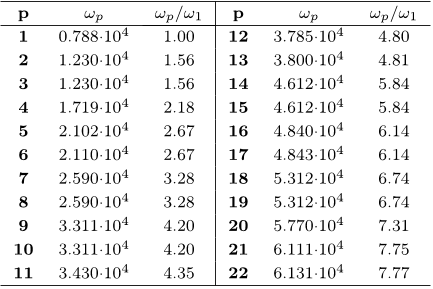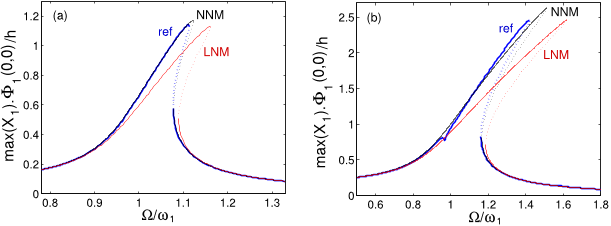




read more











It also paves the way for further fine numerical studies of bifurcation diagrams for shells of arbitrary complex geometry. Such studies will also allow a more extensive assessment of the criterion used in the present paper to select the important modes in the ROM, which can lead to an automatized selection procedure.
In order to have a significant understanding of the possible nonlinear behaviors of a given structure, the computation of a complete bifurcation diagram is key, as it gives access to all the solution branches (stable and unstable) under variations of some selected control parameters.
In conjunction with a numerical continuation method [3,4], or perturbation analytical methods [5], one is able to obtain complete bifurcation diagrams for free vibrations and forced responses of thin structures.
Analytical expressions of the nonlinear coupling coefficients have been expressed from the internal elastic energy by using a modal expansion for the displacement.
The first physical effect that the reduced-order model must mandatorily capture is the coupling between bending and membrane motions.
A converged ROM including 20 linear modes has been shown to predict with excellent accuracy the resonant response of a HP panel in the vicinity of its fundamental frequency.
As peculiar nonlinear phenomena will be exhibited, a very good accuracy on all the numerical values is needed so as to ensure a good convergence of the reduced-order model.
An internal resonance tongue has been found with mode 22, albeit it occurs in a very narrow interval, so that its effect on the global dynamics of the forceddamped system is likely to be negligible.
the authors specifically select linear eigenmodes as a projection basis for the following two reasons:– it allows for a decoupling between linear components, – eigenmodes are easily computable in any standard FE code.
The reduced-order model may be used for either direct time integration, or, as shown next, for computing by a continuation method the bifurcation diagram in the vicinity of a given dynamical state.
This absence of stable periodic orbit is consistent with previous studies on the transition to turbulence for thin plates and shells, see e.g. [34–36], where it has been found that from vibration amplitudes of 2 to 4h (depending on the structure considered), no stable periodic solutions exist anymore, so that the dynamical solution is at least quasi-periodic.
it has been emphasized in [36] that when the internal resonance occurs in a narrow interval as here observed, its influence on the frequency response in the forced-damped system is negligible.
Concerning the M-modes, the mode labeled 224 is the first one in increasing frequency order that shows a strong coupling with the fundamental mode and thus will be key in the selection procedure explained in the next section.
One observes that the hardening behavior is less pronounced, which reveals the effect of adding those modes in order to correctly reproduce the nonlinear vibrating behavior of the panel.
The amplitude limit in the case presented here of the HP panel is found to converge to a value of 2.3h, as shown by the last two truncations which are superimposed, T6 and T7.
This is because the authors need to deal with non-symmetric tensors for the computations of the nonlinear stiffness coefficients in (14)-(15), since the tensor ∇tΦi.
For the full FE model, the maximum amplitude of the transverse displacement at the center is shown, whereas for the ROM the continuation software AUTO gives the maximum amplitude of each coordinate Xp, without their relative phases, so that one is not able to reconstruct precisely the complete transverse displacement by adding all modal coordinates according to Eq. (10).
In order to compute the coefficients gpij and h p ijk consistently with the finite element procedure, the authors thus need to modify the components of the second-order tensors ∇tΦi.
The convergence with this number of high-frequency modes is shown in the insert of Fig. 6, where only the fundamental B-mode is retained with an increasing number of M-modes.